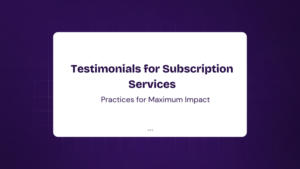Everyone loves a good story, especially one that resonates with their own experiences. But have you ever tried boiling your life’s turning points into a meaningful, concise personal testimony? It’s like trying to fit a week-long vacation into a single Instagram post—challenging but oh-so-rewarding when done right. Whether you’re sharing with a group or delivering a quick 3-minute testimony, this guide is designed to help you prepare, polish, and share your story with clarity, confidence, and authenticity.
What Is a Personal Testimony and Why Does It Matter?
A personal testimony is more than just a narrative—it’s a powerful tool for connection and inspiration. It’s your story of transformation, a window into your experiences, and a way to share how your beliefs, faith, or decisions have impacted your life. Whether used in spiritual, personal, or professional settings, it can serve as a bridge to deeper relationships and common understanding.
Sharing your testimony has ripple effects. As writer Brené Brown aptly puts it, “Vulnerability is the birthplace of connection and the path to the feeling of belonging.” When you share your story, you invite others into your world, showing them they’re not alone in their struggles or triumphs.
How to Prepare a Personal Testimony
Crafting a compelling personal testimony involves both introspection and strategy. Here are some actionable steps to get started:
Reflect on Key Moments
Begin by jotting down the major milestones in your life. Focus on pivotal moments that shaped your values, beliefs, or identity. For instance, think about times when you overcame obstacles, experienced personal growth, or had a life-changing realization.
Identify the Purpose of Your Testimony
Ask yourself: Why am I sharing this story? Is it to inspire, educate, or connect? Your purpose will guide the tone, content, and length of your testimony.
Structure Your Testimony
Organize your story into three simple parts:
- Before: Describe your life or perspective before a significant change occurred.
- During: Highlight the turning point, experience, or realization that changed your perspective.
- After: Share how your life or mindset evolved after the experience.
Keep It Concise
If you’re preparing a testimony for a group discussion or short presentation, aim to keep it under five minutes. Think about your audience’s attention span and focus on delivering the most impactful details.
Practice, But Stay Authentic
Rehearse your testimony, but avoid memorizing it word-for-word. Instead, aim for a natural delivery that feels genuine. Remember, it’s okay to show emotion—it makes your story more relatable.
How to Give Your Testimony with Confidence
Standing in front of an audience, whether big or small, can feel intimidating. Here’s how to deliver your testimony with poise:
Connect with Your Audience
Start with a strong opening that grabs attention. Share a relatable anecdote, ask a thought-provoking question, or use humor to set the tone.
For example: “Do you ever feel like life has a habit of throwing curveballs when you least expect them? Well, mine came with a side of irony.”
Speak from the Heart
While it’s tempting to sound polished, the most impactful testimonies come from a place of honesty. Don’t shy away from being vulnerable—it’s what makes your story real.
Maintain Eye Contact
Engage with your listeners by looking at them directly. This fosters a sense of connection and shows you’re speaking to them, not at them.
Focus on Key Takeaways
What do you want your audience to remember? End with a clear message or call to action that ties back to your story’s purpose.
How to Share Your Testimony in 3 Minutes
Time is a luxury, especially in fast-paced group discussions or events. Sharing your testimony in three minutes requires brevity without sacrificing impact. Here’s how to nail it:
1. Start Strong
Dive right into the most compelling part of your story. Skip long-winded introductions and capture attention immediately.
2. Follow the “Before, During, After” Framework
Use the classic structure, but keep each part concise. Limit yourself to 1-2 sentences for the “before” and focus on the turning point and its impact.
3. End with Impact
Conclude with a memorable takeaway, whether it’s a lesson learned or an invitation to reflect on their own experiences.
How to Write Your Testimony Worksheet
A worksheet can be a game-changer when organizing your thoughts. Use the following prompts to guide your writing:
- What was your life like before your pivotal experience?
- What challenges or questions did you face?
- What was the turning point or realization?
- How did this experience change your perspective or actions?
- What message or lesson do you want to share?
Download a free worksheet template to make the process even easier!
How to Share Your Testimony PDF: Tools for Easy Sharing
Creating a PDF version of your testimony can help you share it effortlessly. Whether for a group discussion or an online audience, PDFs are professional, portable, and printable.
- Tips for Designing Your Testimony PDF:
- Use clear headings and subheadings.
- Include bullet points for key takeaways.
- Add visuals or quotes for impact.
- Platforms for Sharing:
- Email newsletters
- Social media groups
- Event presentations
How to Write a Personal Testimony for a Group Discussion
Group discussions often provide limited time to share. Tailor your testimony to foster engagement and dialogue:
1. Adapt to the Group’s Context
Consider the group’s shared interests, values, or challenges. Align your story with their context for a stronger connection.
2. Encourage Reflection and Questions
End your testimony with an open-ended question, like, “Has anyone else experienced something similar?” This invites others to contribute and keeps the discussion lively.
3. Keep It Conversational
Avoid formal or preachy language. Speak as if you’re having a one-on-one conversation, even in a group setting.
FAQs
What are the key elements of a personal testimony?
The key elements are the “before,” “during,” and “after” phases of your story. Focus on a pivotal experience and its impact on your life.
How do I overcome nervousness when sharing my testimony?
Practice beforehand, focus on connecting with your audience, and remember that authenticity matters more than perfection.
Can I share my testimony without revealing too much personal information?
Absolutely. You can choose to focus on general lessons or insights without diving into deeply personal details.
How can I make my testimony more engaging?
Use storytelling techniques like vivid descriptions, emotional language, and relatable examples to draw in your audience.
What if I forget parts of my testimony while sharing it?
Pause, take a breath, and pick up where you left off. Your audience will appreciate your honesty and effort.
How do I tailor my testimony for different audiences?
Consider their values, interests, and challenges. Adjust your tone and content to align with their context while staying true to your story.
Final Thoughts: Embrace the Power of Your Story
Sharing a personal testimony is a deeply rewarding experience, both for you and your audience. It allows you to reflect on your journey, inspire others, and create meaningful connections. Whether you’re speaking in front of a crowd, participating in a group discussion, or crafting a written testimony, the key is to stay authentic, concise, and purposeful. So, what’s your story, and who are you ready to share it with?



